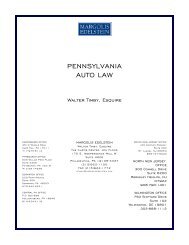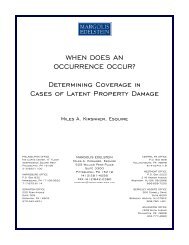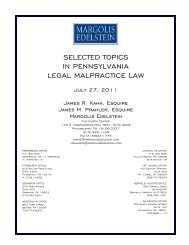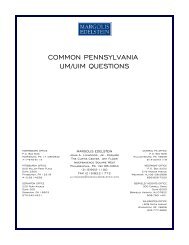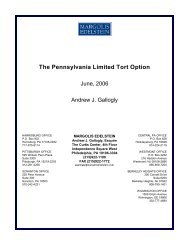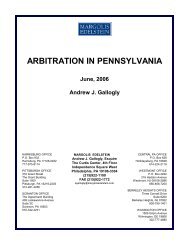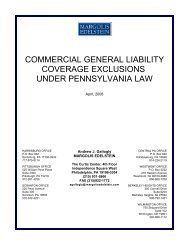The Pennsylvania Supreme court did uphold use of a Frye review to preclude expert testimonyfrom a pla<strong>in</strong>tiff <strong>in</strong> Grady v. Frito Lay, 839 A.2d 1038 (Pa. 2003). In that case an expert had attemptedto testify that the composition of Doritos was defective <strong>in</strong> that its chips were too rigid, even uponchew<strong>in</strong>g, and could become stuck <strong>in</strong> the throat. The trial court had ruled that the expert testimony wasnot based on scientific pr<strong>in</strong>ciples and was thus <strong>in</strong>adequate. The Superior Court had reversed, but theSupreme Court re<strong>in</strong>stated the op<strong>in</strong>ion of the trial court exclud<strong>in</strong>g the evidence after a Frye hear<strong>in</strong>g.4. Proof of causationIn Maresca v. Thomas Jefferson University Hospital,2004 U.S. Dist. LEXIS 8658 (E.D. Pa.2004), aff’d, 135 Fed. Appx. 529 (3rd Cir. 2005), the federal court held <strong>in</strong> a failure to diagnose casethat an expert’s testimony was <strong>in</strong>sufficient to demonstrate that doctors could have prevented or curedthe patient’s condition if the condition had been diagnosed earlier by the defendant physician. But <strong>in</strong>Carrozza v. Greenbaum, 866 A.2d 369 (Pa. Super. 2004), app. den’d, 882 A.2d 1005 (Pa. 2004), theSuperior Court affirmed the trial court’s f<strong>in</strong>d<strong>in</strong>g <strong>in</strong> a failure to diagnose case <strong>in</strong>volv<strong>in</strong>g failure to ordera breast biopsy that the pla<strong>in</strong>tiff had adequately demonstrated an <strong>in</strong>creased risk of harm where thepla<strong>in</strong>tiff’s expert testified that it was “more likely than not” that an earlier biopsy would have found thecancer. Similarly, <strong>in</strong> Vogelsberger v. Magee-Women’s Hospital, 903 A.2d 542 (Pa. Super. 2006) andW<strong>in</strong>schel v. Ja<strong>in</strong>, 925 A.2d 782 (Pa. Super. 2007), the Superior Court held that a pla<strong>in</strong>tiff’s expert onlyhad to testify that the wrongful action by the physician caused an <strong>in</strong>creased risk of harm and the jurycould then determ<strong>in</strong>e if the negligence was a substantial factor <strong>in</strong> caus<strong>in</strong>g the <strong>in</strong>jury.But <strong>in</strong> W<strong>in</strong>schel, the Superior Court limited what the jury could f<strong>in</strong>d for a defendant doctor,revers<strong>in</strong>g a defense verdict and grant<strong>in</strong>g the pla<strong>in</strong>tiff a new trial where the jury had found negligencebut not causation, hold<strong>in</strong>g that it was aga<strong>in</strong>st the weight of the evidence <strong>in</strong> a failure to diagnose casefor a jury not to f<strong>in</strong>d causation where undisputed evidence showed that an additional test was “verylikely” to have led to diagnosis and treatment at that po<strong>in</strong>t “very likely” would have been successfuleven though the experts were not absolutely certa<strong>in</strong> this would have occurred. As noted above, <strong>in</strong>Jacobs v. Chatwani, 922 A.2d 950 (Pa. Super. 2007), the Superior Court noted that the standard of<strong>medical</strong> certa<strong>in</strong>ty for a defense expert <strong>in</strong> her testimony is less than for a pla<strong>in</strong>tiff’s expert. Thus, adefense expert could op<strong>in</strong>e that there was a “possible” alternative cause of the pla<strong>in</strong>tiff’s conditionwithout certa<strong>in</strong>ty as rebuttal to pla<strong>in</strong>tiff’s causation theory s<strong>in</strong>ce the pla<strong>in</strong>tiff has the burden of prov<strong>in</strong>gcausation.In Cacurak v. St. Francis Medical Center, 823 A.2d 159 (Pa. Super. 2003), app. den’d, 844A.2d 550 (Pa. 2004), it was held that an expert physician could not rely on the diagnosis made by aphysician who was not testify<strong>in</strong>g <strong>in</strong> order for the testify<strong>in</strong>g expert to conclude <strong>in</strong> court that the pla<strong>in</strong>tiffhad a particular diagnosis. In Boucher v. Pennsylvania Hospital, 831 A.2d 623 (Pa. Super. 2003), app.den’d, 846 A.2d 1276 (Pa. 2004), it was held that an expert <strong>in</strong> court could be cross-exam<strong>in</strong>ed with areport authored by an expert who was not testify<strong>in</strong>g where that report raised issues of the testify<strong>in</strong>gexpert’s credibility. Also, the testify<strong>in</strong>g expert had reviewed the prior report.Causation as an element of a contributory negligence defense was discussed <strong>in</strong> Rose v. Annabi,2007 Pa. Super. 308 (Pa. Super. 2007), where the court held that missed appo<strong>in</strong>tments by the patient-15-
could not be used to demonstrate contributory negligence without expert testimony that this was asubstantial factor <strong>in</strong> caus<strong>in</strong>g the <strong>in</strong>jury. Nor could failure to provide a family history be contributorynegligence where the treat<strong>in</strong>g physician was aware of the history from other records.5. Informed consentThe Superior Court held <strong>in</strong> Tucker v. Community Medical Center, 833 A.2d 217 (Pa. Super.2003) that there can be no claim aga<strong>in</strong>st a hospital for failure to obta<strong>in</strong> <strong>in</strong>formed consent from a patient,even on a respondeat superior theory as to a doctor work<strong>in</strong>g for the hospital. This followed thedecision of the Pennsylvania Superior Court <strong>in</strong> Valles v. Albert E<strong>in</strong>ste<strong>in</strong> Medical Center, 805 A.2d1232 (Pa. 2002). That year the Supreme Court had also confirmed that an <strong>in</strong>formed consent claimsounds only <strong>in</strong> battery, and cannot be a negligence claim. Montgomery v. Bazaz-Sehgal, 798 A.2d 742(Pa. 2002). In McSorley v. Deger, 905 A.2d 524 (Pa. Super. 2006), it was held that a broad <strong>in</strong>formedconsent form raised a jury issue as to the scope of the patient’s consent, and that expert testimony wasrequired <strong>in</strong> an <strong>in</strong>formed consent claim to prove the nature of the risks of the procedure and thelikelihood of their occurrence. The Superior Court held <strong>in</strong> Isaac v. Jameson Mem. Hosp, 932 A.2d 924(Pa. Super. 2007) that federal Medicaid regulations regard<strong>in</strong>g <strong>in</strong>formed consent for tubal ligations didnot def<strong>in</strong>e the standard of care for provid<strong>in</strong>g <strong>in</strong>formed consent as those regulations were directed toreimbursement issues.6. Corporate liabilityThe Superior Court has held that the corporate liability doctr<strong>in</strong>e is limited to hospitals andHMOs and does not apply to physician practice entities. Sutherland v. Monongahela Valley Hosp.,856 A.2d 55 (Pa. Super. 2004). However, <strong>in</strong> Zamb<strong>in</strong>o v. Hosp. of the Univ. of Pa., 2006 U.S. Dist.LEXIS 69119 (E.D. Pa. 2006), a corporate negligence claim aga<strong>in</strong>st a practice group, a health systemand hospital trustees survived a motion to dismiss allow<strong>in</strong>g proof that the entities controlled thepatient’s care. In Kennedy v. Butler Memorial Hosp., 901 A.2d 1042 (Pa. Super. 2006) dismissalaga<strong>in</strong>st a hospital was held proper where there was no averment that the hospital had notice of theemployees’ negligent care.7. Evidentiary mattersIn Cacurak v. St. Francis Medical Center, 823 A.2d 159 (Pa. Super. 2003), app. den’d., 844A.2d 550 (Pa. 2004), the Superior Court reversed a trial court decision exclud<strong>in</strong>g the evidence thatshowed that a pla<strong>in</strong>tiff exhibited violent behavior. The court believed that the evidence was relevantbecause it refuted the pla<strong>in</strong>tiff’s contention that he was forced to exercise caution <strong>in</strong> car<strong>in</strong>g for his<strong>in</strong>jured neck, which <strong>in</strong>jury was allegedly the result of a negligent surgery. In Papach v. MercySuburban Hosp., 887 A.2d 233 2005 (Pa. Super. 2005), the court held that an ambulance emergency<strong>medical</strong> services report was not a bus<strong>in</strong>ess record or record<strong>in</strong>g of symptoms and was thus <strong>in</strong>admissiblehearsay.-16-



